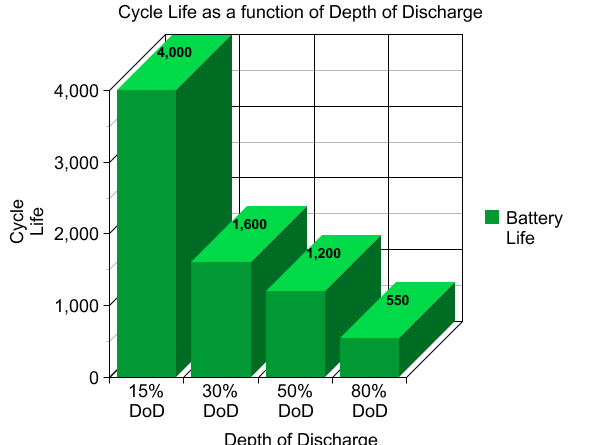EV Batteries Are More Awesome Than We Thought. Probably.
When I went to buy my EV, I was concerned about battery life. Sure, the car would come with a battery warranty, some of which are more awesome than others, but what about after the warranty expired? How much would a battery pack cost to replace? How long would it really last? 8 years? 10? 15? It was all very mysterious, and no one was really making any promises. So, being the giant nerd that I am, I set out on a mission. A mission to figure out how tough the batteries in EVs really are.
I started with the car I would end up buying: the Smart Electric Drive. I scoured the internet, and found a document from the manufacturer. I don’t have permission to reproduce it, but I can give you the highlights:
- ~9000 cycles at 1C (extrapolated)
- 4000 cycles 2C
- 3000 cycles at 3C
Note: All stats are 100% depth of discharge (DoD) to 80% remaining capacity.
These stats are nothing but impressive. At 9000 cycles, and 80 miles per charge, I could expect my Smart Electric Drive to travel 648,000 miles and still have 80% battery capacity! Amazing, no? These are some seriously tough cells! Another interesting point? At 2% DoD cycling, at insanely high rates, the cells lasted 3.5 million cycles! That’s insane! Guess we don’t have to worry about regenerative braking wear!
That’s great for me, but what about the pre-eminent electric car: The Model S? Well, that’s a bit of a trick. You see, the exact cells that Tesla uses are probably unique to them. But we can try to make some educated guesses based on similar Panasonic cells! And it looks like it’s about 300 cycles to 80% capacity, at .3C, for these particular cells. Gee, that seems low, doesn’t it? But let’s really look at this further. How could Tesla use such cells, and not have cars going flat in just a few years? We know that Teslas in the wild seem to be holding up really well!
There are a few main reasons for this:
- Depth of Discharge
- Rate of Discharge
- Temperature Management
- We might not be looking at a valid datasheet
Lets look at each of those a bit closer:

Depth of Discharge
Average depth of discharge in a Tesla is going to be very, VERY low compared to any other electric car. If we look at the average American commute distance of about 15 miles, that would result in a DoD of around 11%. That’s tiny, and will greatly expand cycle life.
As the graph above shows for a similar lithium-ion chemistry, cycle life can be greatly expanded by lower depth of discharge. So, while a Nissan Leaf or a BMW i3 needs to have relatively tough cells to deal with high DoD cycling, a Tesla can use much less expensive cells.
Rate of Discharge
Rate of discharge in a Tesla yields similar gains. Most of these cell tests are performed at relatively high rates of discharge. This is how they are used in consumer electronics, but this is NOT how they are used in cars. At a 1C discharge rate, the P85 would be using 85 kW or 115 hp, and the battery would run flat in an hour. But we know that in the real world, the battery discharges over 5 or more hours (265 miles, 60 mph… do the math). That puts the worst case average discharge rate at .2C or less. Far less for your in town driving. This will also help extend cycle life.
Temperature Management
Temperature management is also key to battery life. This is why most electric cars have chosen to have a full, water-based thermal management system. This system is to keep the battery cool in the summer, and warm in the winter. The impact is huge. At 45 degrees C, battery life is cut in half compared to 25 degrees C! It’s interesting to note that the only car that has had battery life issues that we know of is the Nissan Leaf with its passive cooling system. And even then it’s only in hot climates….
Wrong Datasheet
And finally, you have to question if Tesla is actually using the cells from that datasheet. Tesla is buying enough cells to warrant special treatment here. It’s ripping through hundreds of thousands of cells a week. I’m sure Panasonic is willing to work with Tesla to hit whatever goals it needs. But even if Panasonic isn’t, and these are the cells Tesla is using, I fully expect that they’d be able to stand up for 10+ years and retain 80% capacity, so long as they’re looked after!
In Conclusion…
EV batteries seem to be built way tougher than we thought! I know there is a lot of discussion in the EV community of having to replace batteries at the 8 year mark, right after warranties expire. However, short-range EVs seem to be built with really tough cells, allowing 4000+ discharge cycles, and long-range EVs have low discharge rates, and low depth charge cycling that combines to provide great longevity!
Have a tip for CleanTechnica? Want to advertise? Want to suggest a guest for our CleanTech Talk podcast? Contact us here.
Latest CleanTechnica.TV Video

CleanTechnica uses affiliate links. See our policy here.

